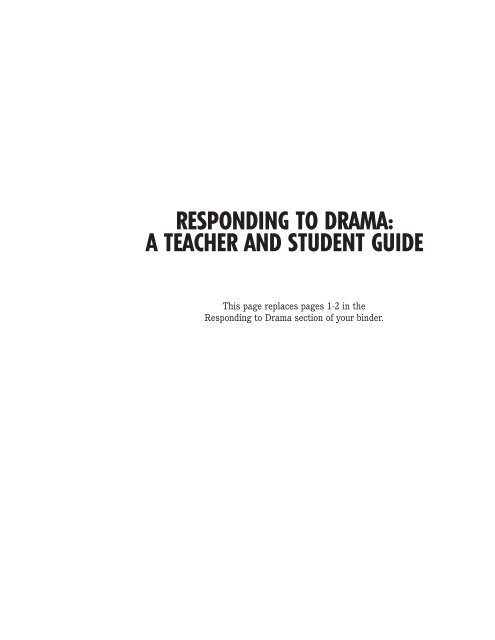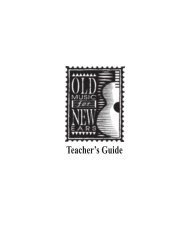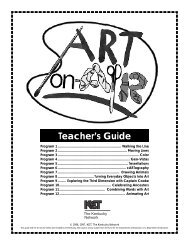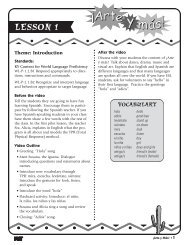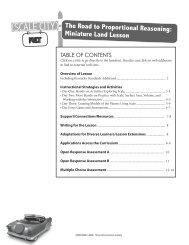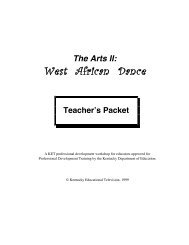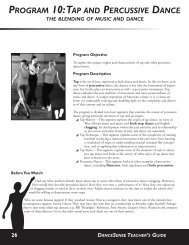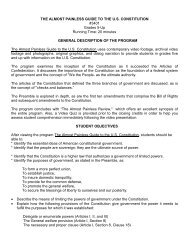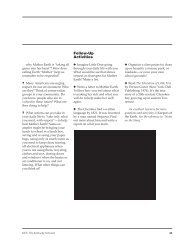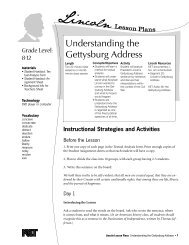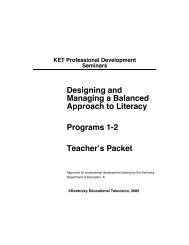responding to drama: a teacher and student guide - KET
responding to drama: a teacher and student guide - KET
responding to drama: a teacher and student guide - KET
Create successful ePaper yourself
Turn your PDF publications into a flip-book with our unique Google optimized e-Paper software.
RESPONDING TO DRAMA:<br />
A TEACHER AND STUDENT GUIDE<br />
This page replaces pages 1-2 in the<br />
Responding <strong>to</strong> Drama section of your binder.
DRAMA 1ST EDITION UPGRADE
Responding <strong>to</strong> Drama<br />
A Teacher <strong>and</strong> Student Guide<br />
Congratulations! In using the Drama Arts Toolkit you are making a commitment <strong>to</strong> <strong>student</strong>s learning in, through,<br />
<strong>and</strong> about <strong>drama</strong> <strong>and</strong> theater in your classroom. This section of the <strong>to</strong>olkit will provide you with information <strong>and</strong><br />
ideas <strong>to</strong> help you prepare <strong>student</strong>s <strong>to</strong> get the most out of attending <strong>drama</strong>tic performances. While this resource<br />
is specifically geared <strong>to</strong> live theatrical performance, many of the suggestions can be easily adapted <strong>to</strong> <strong>responding</strong><br />
<strong>to</strong> film <strong>and</strong> television performances. —Jane Dewey, author<br />
Background: The Importance of the Elements<br />
Theatrical performance can take many forms, including staged readings, reader’s theater, improvisations, work-inprocess<br />
showcases, classroom stagings, one-act plays, <strong>and</strong> full-length plays. But no matter what the form of the performance,<br />
it is likely <strong>to</strong> include some of the elements of <strong>drama</strong>—literary, technical, <strong>and</strong> performance. Which elements<br />
are emphasized <strong>and</strong> how they are put <strong>to</strong>gether make each theater production unique. Looking at the performance<br />
through these elements with purpose <strong>and</strong> focus will deepen <strong>student</strong>s’ underst<strong>and</strong>ing of a theatrical performance.<br />
Elements of <strong>drama</strong> are part of every level of the Kentucky Core Content for Drama <strong>and</strong> include concepts <strong>and</strong> terminology<br />
for all <strong>student</strong>s. Make sure you underst<strong>and</strong> these terms <strong>and</strong> review them with <strong>student</strong>s as appropriate <strong>to</strong> grade<br />
level before <strong>student</strong>s attend <strong>and</strong> respond <strong>to</strong> a theatrical performance. If you need definitions, refer <strong>to</strong> the Drama Arts<br />
Toolkit glossary.<br />
Literary Elements<br />
From Core Content<br />
beginning<br />
character<br />
conflict<br />
dialogue<br />
end<br />
falling action<br />
language<br />
middle<br />
monologue<br />
organization<br />
plot (s<strong>to</strong>ry line)<br />
plot structures<br />
rising action<br />
style<br />
suspense<br />
theme<br />
turning point<br />
Additional possibilities<br />
antagonist<br />
climax<br />
denouement<br />
development<br />
discovery<br />
exposition<br />
foreshadowing<br />
protagonist<br />
symbolism<br />
Technical Elements<br />
costumes<br />
lighting<br />
makeup<br />
music<br />
props<br />
scenery<br />
set<br />
sound<br />
staging<br />
types of stages: arena, thrust,<br />
proscenium<br />
Performance Elements<br />
acting<br />
blocking<br />
body alignment<br />
breath control<br />
character analysis<br />
diction<br />
empathy<br />
facial expression<br />
gestures<br />
inflection<br />
motivation<br />
movement<br />
nonverbal expression<br />
projection<br />
speaking<br />
speaking style<br />
vocal expression<br />
Arts Toolkit Drama • Responding <strong>to</strong> Drama • 1
Underst<strong>and</strong>ing How<br />
We React <strong>to</strong> Drama<br />
What kind of responses do we want <strong>to</strong> encourage <strong>student</strong>s<br />
<strong>to</strong> make <strong>to</strong> <strong>drama</strong>tic performances? Responses can<br />
take many forms, but generally fall in<strong>to</strong> three broad categories.<br />
Some classroom activities may elicit responses<br />
drawing from all three categories. Other activities may<br />
focus on one type of response more than the other.<br />
Immediate Response<br />
This refers <strong>to</strong> the overall impression made by the performance.<br />
Did you like it? Did you underst<strong>and</strong> the s<strong>to</strong>ry<br />
<strong>and</strong> the character relationships? Did the production make<br />
you laugh, cry, sigh with recognition, think?<br />
Intellectual Response<br />
The elements of <strong>drama</strong> can be used <strong>to</strong> help analyze a <strong>drama</strong>tic<br />
performance <strong>and</strong> its effectiveness. Which literary,<br />
technical, <strong>and</strong> performance elements can you identify in<br />
the production? How was each element used? Which elements<br />
were most important <strong>to</strong> conveying the s<strong>to</strong>ry <strong>and</strong><br />
the ideas? Was this an effective way <strong>to</strong> perform this<br />
<strong>drama</strong>?<br />
A written response, such as a review of the performance,<br />
is a good way for <strong>student</strong>s <strong>to</strong> respond intellectually <strong>to</strong> a<br />
theatrical production. Use the Four-<br />
Step Critique Process included<br />
in this resource as a<br />
<strong>guide</strong> for writing a review<br />
or open response answer<br />
or essay. The process can<br />
also be used <strong>to</strong> <strong>guide</strong> a class<br />
discussion. Encourage <strong>student</strong>s<br />
<strong>to</strong> continue thinking <strong>and</strong><br />
<strong>responding</strong> <strong>to</strong> the production<br />
through exp<strong>and</strong>ed research, discussion,<br />
<strong>and</strong> writing.<br />
Artistic Response<br />
A <strong>drama</strong>tic production can be an excellent<br />
springboard <strong>and</strong> source of inspiration for<br />
<strong>student</strong>s <strong>to</strong> express their own feelings,<br />
thoughts, <strong>and</strong> emotions in creative ways.<br />
This can be done individually or in groups<br />
using <strong>drama</strong> or one or more of the other art<br />
forms.<br />
A Four-Step Process for Critiquing a Play<br />
Regardless of what form of response you are asking<br />
<strong>student</strong>s <strong>to</strong> make, this critique process encourages<br />
them <strong>to</strong> take a focused, detailed, <strong>and</strong> specific view of<br />
a theatrical performance. Answering these questions<br />
will assist <strong>student</strong>s in successfully expressing their<br />
immediate, intellectual, <strong>and</strong> artistic responses <strong>to</strong> a<br />
performance. You can adapt this as a h<strong>and</strong>out, use the<br />
process as the basis for a class discussion, develop a<br />
graphic organizer based on the process, or use the <strong>student</strong><br />
worksheets included in this <strong>guide</strong>.<br />
1. Description<br />
Did the production tell the s<strong>to</strong>ry? What did I actually<br />
see <strong>and</strong> hear during the performance?<br />
(Explain <strong>to</strong> <strong>student</strong>s that it’s good <strong>to</strong> start with the facts of the<br />
performance. Remind them that the performance may be slightly<br />
different from the written script. If the performance is an adaptation,<br />
it could be very different from the short s<strong>to</strong>ry or novel from<br />
which it is taken.)<br />
2. Analysis<br />
How does this particular performance come <strong>to</strong> life? How<br />
were the elements of <strong>drama</strong>—literary, technical, <strong>and</strong> performance—used?<br />
(Review the elements with <strong>student</strong>s before they see the production.<br />
To help them focus, you may want <strong>to</strong> identify certain elements<br />
for them <strong>to</strong> pay special attention <strong>to</strong> as they watch.)<br />
3. Interpretation<br />
What’s the point? What ideas or themes are conveyed?<br />
How does what happens—the plot—relate <strong>to</strong> the major<br />
ideas or themes of the production?<br />
(Make sure <strong>student</strong>s underst<strong>and</strong> the difference between plot <strong>and</strong><br />
theme. Ask them <strong>to</strong> look for ideas <strong>and</strong> experiences conveyed in<br />
the performance that remind them of their own lives.)<br />
4. Judgment<br />
Was this production enjoyable? How did it make me feel?<br />
Did it make me think? Would I recommend that others<br />
see it?<br />
(Encourage <strong>student</strong>s <strong>to</strong> support their opinions with specific<br />
examples from the production. Remind them that their examples<br />
should draw from the elements of <strong>drama</strong> <strong>and</strong> use appropriate<br />
<strong>drama</strong>/theater terminology.)<br />
2 • Arts Toolkit Drama • Responding <strong>to</strong> Drama


